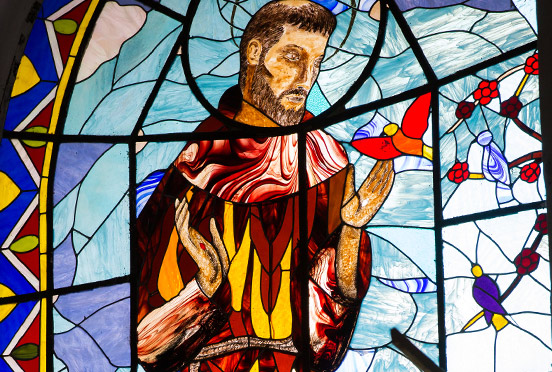 On the first weekend in October, thousands of Christian churches — Catholic and Protestant alike — around the world will celebrate the feast day (October 4) of Saint Francis of Assisi by holding the Blessing of the Animals. This ceremony generally takes place outdoors in the church’s parking lot where parishioners and visitors have gathered, accompanied by their dogs, cats, and other pets. Its purpose? To give a special blessing to each individual animal similar to the following:
On the first weekend in October, thousands of Christian churches — Catholic and Protestant alike — around the world will celebrate the feast day (October 4) of Saint Francis of Assisi by holding the Blessing of the Animals. This ceremony generally takes place outdoors in the church’s parking lot where parishioners and visitors have gathered, accompanied by their dogs, cats, and other pets. Its purpose? To give a special blessing to each individual animal similar to the following:
Blessed are you, Lord God, maker of all living creatures. You called forth fish in the sea, birds in the air and animals on the land. You inspired Saint Francis to call all of them his brothers and sisters. We ask you to bless this pet. By the power of your love, enable it to live according to your plan. May we always praise you for all your beauty in creation. Blessed are you, Lord our God, in all your creatures! Amen.
Centuries-Old Tradition
The blessing of animals dates back 800 years to the life of Saint Francis of Assisi (1181–1226). Born Giovanni di Pietro di Bernardone in Assisi, Italy, his early life was one of luxury since his father was a rich merchant. But when war broke out between Assisi and Perugia in 1202, young Giovanni joined his countrymen’s cavalry. He was wounded and captured by the enemy in one of the battles and held in prison for over a year until his father paid the heavy ransom required to release him.
Giovanni returned home a changed man. No longer interested in his former lifestyle, he instead began focusing on God, spending much time in an old Byzantine church and a remote mountain hideaway praying and looking for answers to life’s profound questions. Ultimately he believed he heard the voice of God telling him to live a life of extreme poverty and rebuild the church.
Giovanni headed the call, exchanging his elegant clothing for a dark rough tunic and assembling a group of 12 local followers so as to go out and preach the Gospel. He also took Francis as his new name. His extreme form of Christ-like poverty was a radical idea at the time.
However, his charismatic personality and preaching soon resulted in hundreds of people coming to hear him wherever he went.
First Blessing of Animals
Saint Francis first blessed animals early in his ministry sometime between 1210–1215. The story goes that he was wandering around outdoors one warm afternoon, full of self-doubt, when he noticed a flock of birds in his path. He immediately felt the need to first talk to them as though they were his equals and then preach to them about God’s glories and the reasons why men and animals should be grateful for these blessings. One might say that this was also the beginning of the environmental movement since Francis recognized that human beings are intrinsically connected to all of creation.
A few years later in 1223, Saint Francis also was responsible for the first outdoor Christmas Nativity scene featuring live animals. He took a borrowed donkey, a wax statue of the Baby Jesus, a trough of straw, and volunteer humans to portray Mary and Joseph into a cave. There he created a living, breathing Nativity scene that all the locals could easily understand without being able to read the Christmas story in the Bible.
Franciscan Legacy Today
At the age of only 44, Francis died in Assisi on October 4, 1226. Pope Gregory IX canonized him as a saint less than two years later. He was later designated as the patron saint of animals due to his great love for them during his lifetime. His little band of followers long since grew and evolved into the Order of St. Francis, a/k/a the Franciscans, whose monks, friars, and priests minister to the poor around the world. When elected to the papacy, the current pope took the name of Francis in honor of Saint Francis of Assisi.
But today Saint Francis of Assisi belongs to the world, not just to Catholics and other Christians. His statue can be found in many public and private gardens, usually surrounded by animals and with a bird lighting on one of his hands. The Humane Society of the United States devotes a full page to Saint Francis on its website, and many ecologists and activists view him as the originator of what has now become the worldwide environmental movement.
Add Your Comment